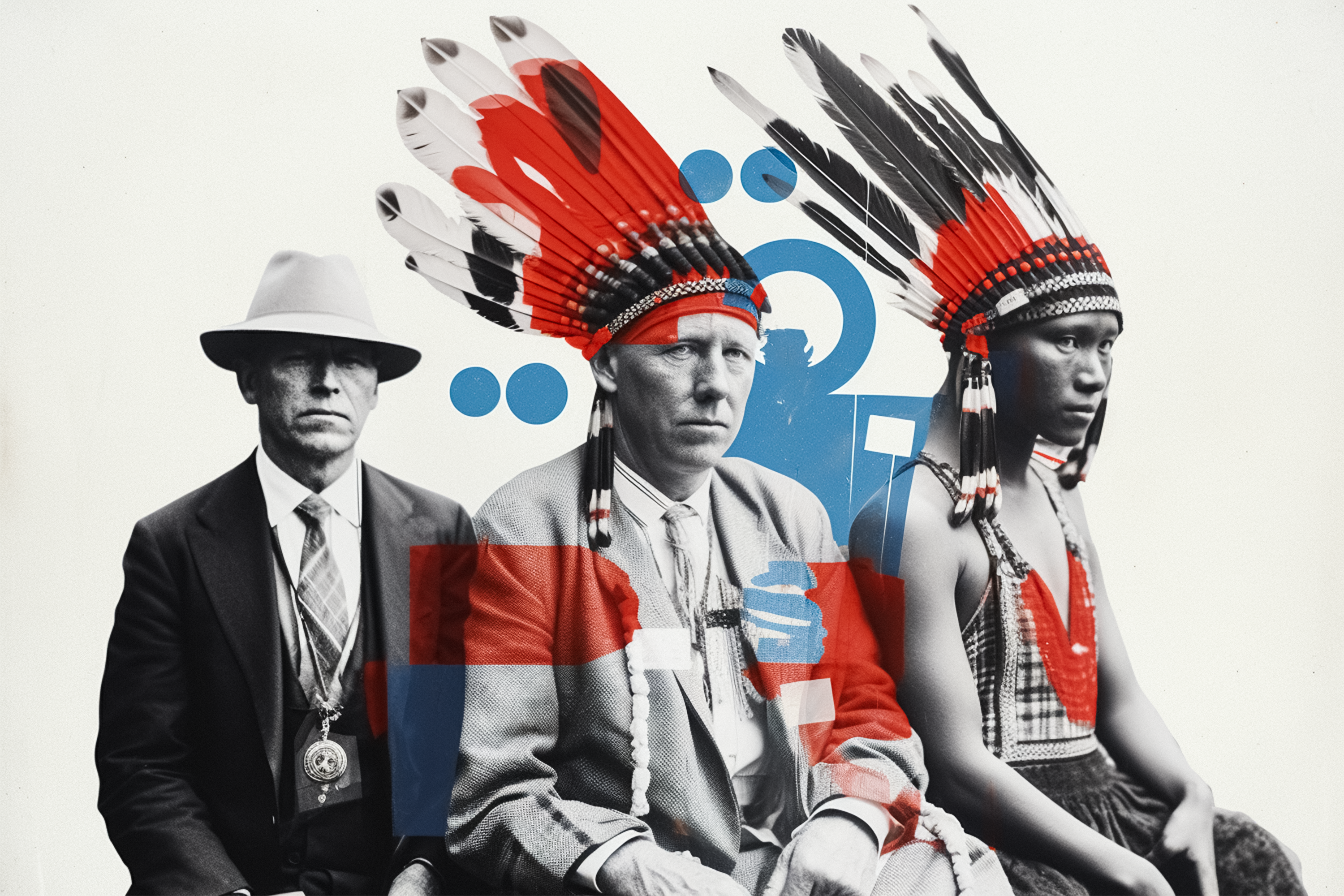- Introduction and overview
- What is qualitative research?
- What is qualitative data?
- Examples of qualitative data
- Qualitative vs. quantitative research
- Mixed methods
- Qualitative research preparation
- Theoretical perspective
- Theoretical framework
- Literature reviews
- Research question
- Conceptual framework
- Conceptual vs. theoretical framework
- Data collection
- Qualitative research methods
- Interviews
- Focus groups
- Observational research
- Case studies
- Surveys
- Ethnographical research
- Ethical considerations
- Confidentiality and privacy
- Bias
- Power dynamics
- Reflexivity
- How to cite "The Ultimate Guide to Qualitative Research - Part 1: The Basics"
What is ethnographic research?
An ethnographic study is one of the most ambitious endeavors a researcher can pursue in qualitative research. It involves using several ethnographic methods to observe and describe social life, social relations, or human society as a whole. Time-consuming and arduous as the data collection and data analysis might be, conducting an ethnography can be one of the most rewarding challenges in cultural anthropology, social anthropology, and similar qualitative research areas.

Let's look at the fundamentals of ethnographic research, examples of ethnographic studies, and the fundamentals of ethnography as a qualitative research method.
Defining ethnographic research
"Culture" is an ambiguous term that resists an easy definition. What defines a culture? What takes place inside a culture? What cultures does a particular individual belong to? Who decides who belongs to any specific culture?
Even within a particular context, there are several layers of cultures. Take the United States, for example. Given how diverse and as big as it is, how can one define American culture in as brief an explanation as possible? What are the different social groups within this one country, and how do those groups interact with each other?
Quantitative research is often incapable of capturing such detail, especially because it is extremely difficult to adequately capture a culture in quantitative terms. As a result, researchers often conduct traditional ethnographic research when they want to understand a culture. A credible, written account of a social group is challenging to produce. It requires looking at participant experiences, interviews, focus groups, and document collection, which are different ways to collect data for ethnographic research.
Ethnography belongs squarely in the realm of observational research. In other words, writing culture and cultural critique cannot be based on experiments performed in controlled settings. Ethnography aims to provide an immersive experience in a culture for audiences who are unfamiliar with it. In that case, the researcher must observe the intricate dimensions of social interaction in its natural environment. In ethnographic research, this observation is active and involves being part of the culture to understand the dimensions of cultural norms from the inside.
That said, even observation alone cannot capture concepts such as social relationships or cultural practices. Researchers conducting ethnographic studies acknowledge that simply observing and describing actions are insufficient to grasp social interaction fully. The concept of thick description, or the description of perspectives and beliefs informing those actions in addition to the actions themselves, guides the use of various methods to capture social phenomena from multiple angles.
What is the purpose of ethnographic research?
Ethnographic studies are heavily used in social and cultural anthropology disciplines to generate and expand theory. Outside of anthropology, the insights uncovered by ethnography help to propose or develop theories that can be verified by further qualitative or quantitative research within the social and human sciences.
In simple terms, ethnographic studies relate what a culture is to audiences who are otherwise unfamiliar outsiders. Armed with this understanding, researchers can illustrate and persuade audiences about patterns that emerge from a community or group of people. These patterns are essential to generating theory and pioneering work.
What are examples of ethnographic research?
Ethnographic research aims to reach a deep understanding of various socially-constructed topics, including:
- Rituals and other cultural practices in everyday life
- Social interaction among people of different cultures
- People's interactions with their natural environment
- Creation of and tensions in social relationships
Ethnography as a qualitative method is common in social and cultural anthropology and any scholarly discipline concerned with social interaction. The traditional role of ethnography is to inform scholars interested in cultures they wouldn't otherwise have contact or experience with. Various topics that have been explored by such research with ethnography include:
- health care workers interacting with patients
- teachers and students constructing classroom dialogue
- workplace relations between employees and managers
- experiences of refugees in conflict zones
Other disciplines, especially in the social sciences, employ ethnographic research methods for varied reasons, including understanding:
- effective teaching practices
- socialization processes
- intercultural cohesiveness
- company-customer relations
The range of inquiries that ethnography can answer is vast, highlighting the importance of ethnographic methods in studies where the researcher seeks a deep understanding of a particular topic.
What are the methods in ethnographic research?
Even within anthropology, there is a lack of consensus on the particular processes for conducting research through ethnography. Interaction among people is unpredictable to the extent that the researcher might encounter unexpected issues with research participants not foreseen at the outset of a study. Because no observational research can be conducted in a fully controlled setting, it is a challenge to define an exact process for an ethnography beyond the general principles guiding an ethnographic approach.
In broad terms, ethnographic data collection methods are varied. Still, all such methods carry the assumption that a single research method cannot fully capture a thorough understanding of a cultural phenomenon. A systematic study that employs ethnographic research methods collects data from observations, participant observations, and interviews. The researchers' reflections also contribute to the body of data since personal experiences are essential to understanding the unfolding ethnography.
Participant observation
At the core of field research is a method called participant observation. Scholars in contemporary ethnography have long acknowledged the importance of active participation in understanding cultural life. This method allows the researcher to experience activities and interactions alongside participants to establish an understanding they wouldn't otherwise achieve by observing from afar.
In active participant observation, the ethnographic researcher takes field notes of what they see and experience. They are essential during fieldwork as they create a record that the researcher can look at later on to structure their analysis and recall key developments useful to data analysis.

During participant observation, the researcher may also collect other forms of data, including photographs and audio and video recordings. Sensory data is beneficial to ethnography because it helps the researcher recall essential experiences with vivid detail and provides potentially abundant supporting evidence for the arguments in their findings.
Interviews and focus groups
Participant observation provides data for seeing what people say and do in their natural environment. However, observation has its limits for capturing what people think and believe. As a result, an ethnographic researcher conducts interviews to follow up on what they saw in fieldwork with research participants.
A common type of interview in an ethnography is the stimulated recall interview. In a stimulated recall interview, research participants are asked questions about the events the researcher observed. These questions help research participants remember past experiences while providing the researcher with their way of thinking about those experiences.
A focus group involves interactions between the researcher and multiple research participants. Suppose the researcher is interested in the interpersonal dynamics between research participants. In that case, they might consider conducting focus groups to elicit interactions that are markedly different from one-on-one exchanges between a single research participant and the researcher.
Interviews and focus groups also help uncover insights otherwise unfamiliar to the researcher, who can then use those insights to guide their theoretical understanding and further data collection.
Document collection
Documents often make up an essential aspect of cultural practices. Think about these examples:
- student homework
- medical records
- newspaper articles
- informational posters
The visual elements uncovered during an ethnography are potentially valuable to theoretical insights, and a researcher might find it important to incorporate documents in their project data.
Reflections
In any ethnography, the researcher is the main instrument of data collection. Their thoughts and beliefs are consequential to the data analysis in that any theoretical insights are filtered by their interpretations. As a result, a researcher should take field notes during participant observation and reflection notes about any connections between what they saw and what it might mean for generating theory during data analysis.
As with taking field notes, a researcher might not remember all the different things that transpire during an ethnography without being able to refer to some sort of record later on. More importantly, reflecting on theory during participant observation may be challenging. A useful practice involves sitting down after observations or interviews and writing down potential theoretical insights that come to mind.
Reflections guide participant observations during an ethnography and theoretical analysis afterward. They point the researcher toward phenomena that are most relevant to theory and guide discussion of that theory when the time comes to write a description of their ethnographic study.
Organizing data
With a research approach as complex as ethnography, you will likely collect abundant data that require organization to make the analytical process more efficient. Researchers can use ATLAS.ti to store all their data in a single project. Document groups allow you to categorize data into different types (e.g., text, audio, video), different contexts (e.g., hospital room, doctor's office), or even different dates (e.g., February 17th observation, March 21st observation).
Moreover, researchers can integrate text with multimedia in ATLAS.ti, which is ideal for analyzing interviews, because you can look at transcripts and their video or audio recordings simultaneously. This is a valuable feature in ethnographic studies examining how people speak and what they say. Photos and other visual documents can also easily be incorporated and analyzed, adding further valuable dimensions to your research.
How do I conduct an ethnography?
Now that we have established a foundational understanding of the various methods associated with ethnography, let's look at what an ethnographic approach to research might look like.
Defining your research questions
As with any research study, ethnographic studies begin when researchers want to know more about something unfamiliar. Do you want to understand how a particular group of people interact with their natural environment? What about how group members decide on a social structure? How is daily life affected by changing economic conditions over a long period of time?
Ethnographic research may also be appropriate for conducting a comparative study of multiple cultures. For example, consider the different groups of soccer fans in several parts of the world: fans in South America might act differently from fans in Europe or Asia. Teaching and learning in high school are bound to look different than teaching and learning in university settings. Emergency room medicine and hospice care have distinct purposes that affect the nature of interactions between doctors and patients.
Whatever the inquiry, the researcher benefits from defining a focus for their ethnography. A clear research question can help the researcher narrow their field of perception during participant observation. Suppose the research question has to do with doctor-patient interactions. In that case, the ethnographer can lend more focus to those conversations and less emphasis on ancillary developments within their research context. With a more specific view, they can examine how doctors speak to their patients while being less concerned about the hospital executives in earshot or the orderlies passing by unless and until they are relevant to the research inquiry.
Choosing theoretical perspectives
To further narrow the focus of the ethnography, a theoretical lens can direct the ethnographer toward aspects relevant to theory. Continuing with the example regarding doctor-patient interactions, let's imagine that the ethnographic study explores the role of reassuring language in situations regarding dire medical conditions. Are there relevant theories about what people can say to give peace of mind to others?
Typically, theories in qualitative research consist of a framework with discrete indicators you can use to organize knowledge. For example, let's suppose that there exists a concept of reassurance that can be broken down like this:
empathy - understanding and affirming other people's emotions
evidence - providing examples of favorable results in similar situations
responsiveness - actively listening to and validating others' concerns
With this sort of theory in mind, an ethnography can focus on listening for instances of these particular indicators during participant observation and recording these examples in field notes. Naturally, a theory is more credible if it's grounded in previous research.
Entering ethnographic fieldwork
The next step is to choose an appropriate and accessible context for your ethnography. Ethics are an important part of contemporary research in the social sciences, requiring permission from potential participants to observe and interact with them for research purposes.
Before any meaningful data collection, make sure to obtain informed consent from the research participants you are studying. Essentially, this involves receiving permission from your participants to document what they say and do after explaining the purpose of your study and the rights they have while participating in your ethnography.

Ethnographic collection of data
With a context and theory in mind, it's now time to conduct your ethnography. In general terms, this means entering the field and capturing as much rich data relevant to your research question as possible.
Good ethnographic practice relies on pursuing multiple research methods to capture data. Participant observation can help you document what people say and do, but good ethnographies also capture what people believe about their everyday actions.
However, the research method most associated with ethnographic research is note-taking. Field notes capture the researcher's personal experience with the culture they observe, which is necessary to fully understand the captured data. With the ethnographer as the main instrument of data collection, readers of ethnographic studies can attain a sense of the possible ways they can view cultures through the researcher's eyes.
Moreover, ethnography relies on rapport with research participants. Ethnographers who want to conduct interviews later will benefit from establishing good relationships with their research participants. As a result, more involved interactions during fieldwork can generate deeper and richer data for your study.
Considerations during fieldwork
It's important to remember that the ethnographer's presence can affect how people behave. Especially in participant observation, your interactions with research participants will directly influence what they do in their daily lives. Even our natural environment is affected by what we do in it. When writing your reflections, qualifying your interactions in the field with a sufficient accounting of how your presence might change what others say and do is important.
There are also ethical questions about what to document and how to use the resulting data afterward. Within anthropology, there are issues of representing cultural groups with respect and ensuring you have their permission to use what you observe and collect from the field. Top scholarly journals and academic conferences also want to know how you observed research ethics during fieldwork, so it is necessary to use your reflection memos to document your ethics practices in addition to the data you collect.
Further development in ethnographic fieldwork
Unexpected issues in field research, especially long-term fieldwork, can help you refine your theoretical framework. Returning to the example of the concept of reassurance, you might observe a doctor's explanation of a medical procedure and find that it's similar to providing evidence. Still, it does not fully align with the established theory. In other words, studying real-world episodes of medical explanations may contribute novel insights about reassurance, helping you further develop your focus in subsequent observations.
As you continue your ethnography, refining the scope of your theoretical perspective helps you more easily gather observational data relevant to your research inquiry and thus provide a fully developed framework for your data.



